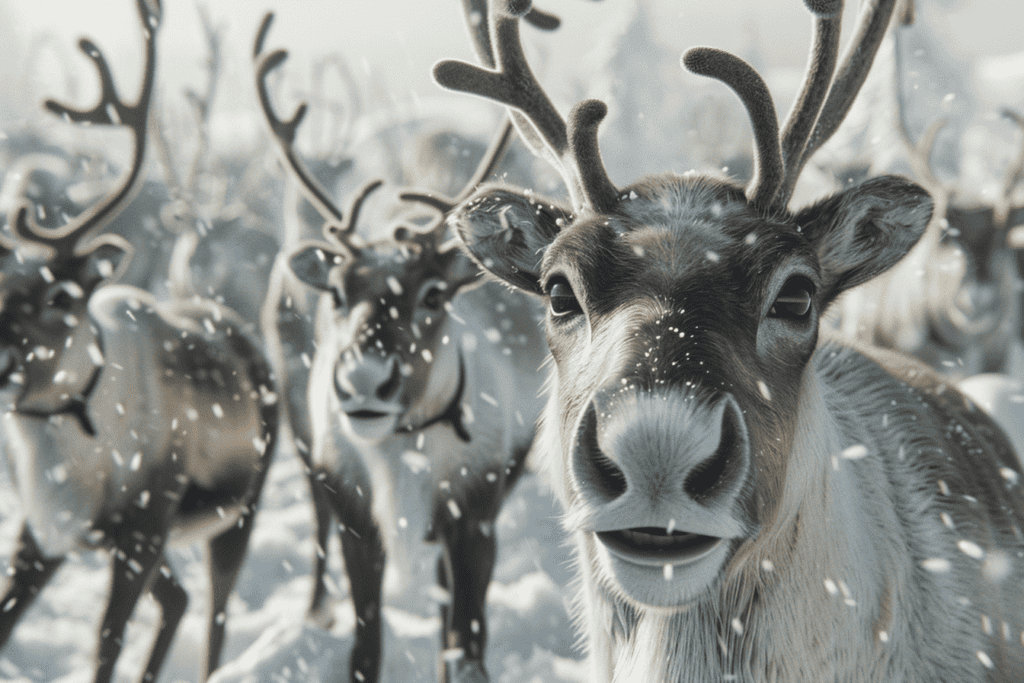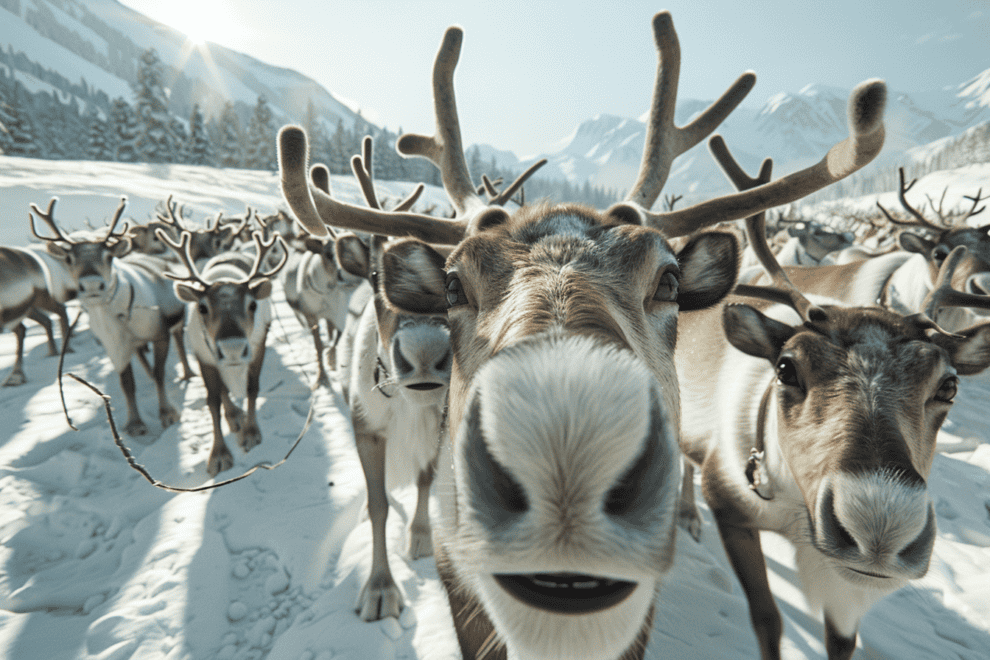Reindeer undertake an epic 3,000-mile trek every year in search of food, making them one of the most traveled land animals.
Traveling in large herds, often led by seasoned females, they endure harsh weather and difficult terrain. Their stunning fur reflects sunlight, providing insulation as they push through icy landscapes.
Climate change, habitat fragmentation, and human activities like mining create significant obstacles, but reindeer are resilient and their ability to conserve energy and adapt to food scarcity is remarkable.
An Ancient Migration
Reindeer have been migrating across Arctic landscapes for thousands of years, adapting to changing climates and environments.
You can imagine these majestic creatures moving in unison, their hooves crunching through snow and ice.
This ancient pattern of movement is especially evident in the Northwest Territories, where reindeer herding has been a way of life for the Inuit people. They’ve skillfully managed herds, ensuring survival through seasons of scarcity and abundance.
The Mackenzie River, one of the longest river systems in Canada, serves as a critical landmark in these migrations.
It’s along this river that you’ll find both wild reindeer and those managed by humans.
The Inuit people have developed a deep relationship with these animals, relying on them for food, clothing, and even transportation.
This relationship has been built on respect and understanding of the reindeer’s natural behaviors and needs.
Reindeer herding isn’t just a practice; it’s a tradition that carries immense cultural significance.
It has shaped the lives of the Inuit people and defined their connection to the land.
As you follow the reindeer’s journey, you’ll see how these ancient practices continue to influence modern life in the Arctic.

Challenges Faced
As reindeer and caribou set out on their 3,000-mile route in search of food, the challenges they face are immense. In recent decades, climate change has drastically altered their migratory patterns, making it harder to find consistent food sources. You’ll find that warmer temperatures have led to unpredictable weather, causing freezing rain that creates ice layers over the vegetation reindeer depend on.
The terrain itself is a formidable adversary. The Arctic’s rugged landscape, with its icy rivers and vast snowfields, demands significant physical effort.
They have to navigate through treacherous conditions, often with limited visibility due to snowstorms. Predators like wolves and bears pose additional threats, requiring constant vigilance and group coordination for protection.
Human activity has also added to the challenges faced. Infrastructure development and increased industrial activity disrupt traditional migratory routes, forcing reindeer to take longer, more arduous paths.
These disruptions not only increase the distance but also the energy expenditure needed to reach essential feeding grounds. The journey is a relentless test of survival, demanding every ounce of strength and adaptability.
The Work of Andrew Bahr And His Role In Helping The Reindeer

Andrew Bahr’s expertise in wildlife biology has been instrumental in studying and mitigating the challenges faced by reindeer during their arduous migration.
His work primarily focuses on collaborating with reindeer herders, who play a pivotal role in the reindeer industry. These herders rely on accurate data and effective strategies to safeguard the well-being of their herds.
Andrew’s research provides invaluable insights into the behavior and needs of reindeer, especially during their long treks across varied and often harsh landscapes.
His fieldwork involves tracking Canadian reindeer using GPS collars and drone technology to gather data on their migratory patterns. By understanding these patterns, Andrew helps herders make informed decisions about where to guide their herds for ideal grazing.
Andrew also conducts workshops for these small town herders, sharing his findings and offering practical solutions to the challenges they face.
His contributions haven’t only improved the efficiency and sustainability of the reindeer industry but also strengthened the bond between scientific research and traditional herding practices.
This collaboration ensures a more secure future for both the reindeer and the communities that depend on them.
Arrival and Impact

The reindeer’s arrival at their migratory destination marks a pivotal juncture in their journey, profoundly impacting their survival and the ecosystems they traverse.
After a grueling 3,000-mile migration, these resilient animals finally reach areas where food sources like lichens, mosses, and other vegetation are more abundant. This moment is essential as they need to replenish the body weight lost during their arduous trek, which can be up to 40% due to food scarcity in the Arctic tundra.
You can imagine the relief these creatures must feel upon finding these indispensable food supplies. The reindeer’s survival hinges on this replenishment, allowing them to build strength for the next phase of their life cycle.
The impact of their arrival extends beyond their own survival, too. As they graze, reindeer help maintain the balance of the vegetation, preventing overgrowth and promoting biodiversity.
However, their migration and subsequent arrival are increasingly threatened by climate change. Shifts in temperature and weather patterns are altering the availability of their food sources, disrupting their traditional routes.
Reindeer herders and conservationists are tirelessly working together to protect these critical habitats, ensuring the long-term survival of the reindeer and the ecosystems they sustain.
Legacy and Significance

As reindeer reach their migratory destinations and rejuvenate, their legacy and significance within the Canadian Arctic become undeniable.
The reindeer industry in Canada, established in the 1920s, has experienced its share of ups and downs. Initially led by the Canadian government and immigrant Lapland herders, this monumental project faced a major setback in the 1930s, collapsing under economic pressures. However, recent decades have seen a concerted effort to conserve and protect reindeer habitats and populations, breathing new life into the industry.
The legacy of the reindeer drive is a tribute to the perseverance and determination of those involved. This incredible journey has had a lasting impact on the Canadian Arctic and its indigenous communities.
For many, reindeer aren’t just animals; they’re a crucial part of cultural heritage, providing food, clothing, and other essential resources.
Today, the reindeer industry continues to play an important role in Canada’s economy. Indigenous communities, in particular, rely on reindeer for their livelihoods, intertwining their lives with these remarkable animals. The reindeer’s long trek symbolizes endurance and adaptability, reflecting the resilient spirit of the Arctic and its inhabitants.
Frequently Asked Questions
What Do Reindeers Typically Eat During Their Long Migration?
They primarily consume lichen, showcasing dietary adaptations to meet nutritional needs. Forage preferences shift with seasonal changes, ensuring they get the necessary nutrients throughout their long journey.
How Do Reindeers Navigate Such Long Distances?
Reindeers navigate long distances using celestial navigation and magnetic fields. They rely on herd dynamics, seasonal cues, and environmental landmarks to find their way. Their keen sense of smell also aids in tracking their migratory routes.
What Is the Average Speed of a Migrating Reindeer?
You’ll find that migrating reindeer average about 3-4 kilometers per hour. Climate change, seasonal patterns, herd dynamics, energy expenditure, and rest periods all impact this speed, making it vital for their survival and migration efficiency.
How Do Reindeers Communicate With Each Other During Migration?
Reindeers communicate using vocal signals, scent marking, and body language. You’ll notice their social hierarchy helps maintain group cohesion. Each method facilitates they stay connected and navigate effectively during their long migrations.
Are There Specific Predators That Target Migrating Reindeers?
Yes, there are specific predators that target migrating reindeers. You’ll notice predator behaviors and adaptations that heighten predation risks. Seasonal threats include wolves and bears, while reindeers employ defense mechanisms like herding to mitigate these dangers.









